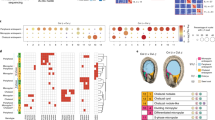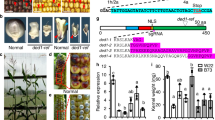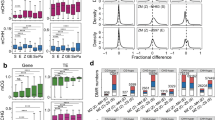Abstract
In plants, imprinted gene expression occurs in endosperm seed tissue and is sometimes associated with differential DNA methylation between maternal and paternal alleles1. Imprinting is theorized to have been selected for because of conflict between parental genomes in offspring2, but most studies of imprinting have been conducted in Arabidopsis thaliana, an inbred primarily self-fertilizing species that should have limited parental conflict. We examined embryo and endosperm allele-specific expression and DNA methylation genome-wide in the wild outcrossing species Arabidopsis lyrata. Here we show that the majority of A. lyrata imprinted genes also exhibit parentally biased expression in A. thaliana, suggesting that there is evolutionary conservation in gene imprinting. Surprisingly, we discovered substantial interspecies differences in methylation features associated with paternally expressed imprinted genes (PEGs). Unlike in A. thaliana, the maternal allele of many A. lyrata PEGs was hypermethylated in the CHG context. Increased maternal allele CHG methylation was associated with increased expression bias in favour of the paternal allele. We propose that CHG methylation maintains or reinforces repression of maternal alleles of PEGs. These data suggest that the genes subject to imprinting are largely conserved, but there is flexibility in the epigenetic mechanisms employed between closely related species to maintain monoallelic expression. This supports the idea that imprinting of specific genes is a functional phenomenon, and not simply a byproduct of seed epigenomic reprogramming.
This is a preview of subscription content, access via your institution
Access options
Subscribe to this journal
Receive 12 digital issues and online access to articles
$119.00 per year
only $9.92 per issue
Buy this article
- Purchase on Springer Link
- Instant access to full article PDF
Prices may be subject to local taxes which are calculated during checkout




Similar content being viewed by others
References
Gehring, M. Genomic imprinting: insights from plants. Annu. Rev. Genet. 47, 187–208 (2013).
Haig, D. & Westoby, M. Parent-specific gene expression and the triploid endosperm. Am. Nat. 134, 147–155 (1989).
Hsieh, T.-F. et al. Regulation of imprinted gene expression in Arabidopsis endosperm. Proc. Natl Acad. Sci. USA 108, 1755–1762 (2011).
Wolff, P. et al. High-resolution analysis of parent-of-origin allelic expression in the Arabidopsis Endosperm. PLoS Genet. 7, e1002126 (2011).
Gehring, M., Missirian, V. & Henikoff, S. Genomic analysis of parent-of-origin allelic expression in Arabidopsis thaliana seeds. PLoS ONE 6, e23687 (2011).
Pignatta, D. et al. Natural epigenetic polymorphisms lead to intraspecific variation in Arabidopsis gene imprinting. eLife e03198 (2014).
Luo, M. et al. A genome-wide survey of imprinted genes in rice seeds reveals imprinting primarily occurs in the endosperm. PLoS Genet. 7, e1002125 (2011).
Waters, A. J. et al. Parent-of-origin effects on gene expression and DNA methylation in the maize endosperm. Plant Cell 23, 4221–4233 (2012).
Xin, M. et al. Dynamic expression of imprinted genes associates with maternally controlled nutrient allocation during maize endosperm development. Plant Cell 25, 3212–3227 (2013).
Zhang, M. et al. Extensive, clustered parental imprinting of protein-coding and noncoding RNAs in developing maize endosperm. Proc. Natl Acad. Sci. USA 108, 20042–20047 (2011).
Zhang, M. et al. Genome-wide high resolution parental-specific DNA and histone methylation maps uncover patterns of imprinting regulation in maize. Genome Res. 24, 167–176 (2014).
Moreno-Romero, J., Jiang, H., Santos-González, J. & Köhler, C. Parental epigenetic asymmetry of PRC2-mediated histone modifications in the Arabidopsis endosperm. EMBO J. 35, 1298–1311 (2016).
Patten, M. M. et al. The evolution of genomic imprinting: theories, predictions and empirical tests. Heredity 113, 119–128 (2014).
Waters, A. J. et al. Comprehensive analysis of imprinted genes in maize reveals allelic variation for imprinting and limited conservation with other species. Proc. Natl Acad. Sci. USA 110, 19639–19644 (2013).
Berger, F., Vu, T. M., Li, J. & Chen, B. Hypothesis: selection of imprinted genes is driven by silencing deleterious gene activity in somatic tissues. Cold Spring Harb. Symp. Quant. Biol. 77, 23–29 (2012).
Kawashima, T. & Berger, F. Epigenetic reprogramming in plant sexual reproduction. Nat. Rev. Genet. 15, 613–624 (2014).
Beilstein, M. A., Nagalingum, N. S., Clements, M. D., Manchester, S. R. & Mathews, S. Dated molecular phylogenies indicate a Miocene origin for Arabidopsis thaliana. Proc. Natl Acad. Sci. USA 107, 18724–18728 (2010).
Morison, I. M. & Reeve, A. E. A catalogue of imprinted genes and parent-of-origin effects in humans and animals. Hum. Mol. Genet. 7, 1599–1609 (1998).
Danilevskaya, O. N. et al. Duplicated fie genes in maize: expression pattern and imprinting suggest distinct functions. Plant Cell 15, 425–438 (2003).
Matzke, M. A. & Mosher, R. A. RNA-directed DNA methylation: an epigenetic pathway of increasing complexity. Nat. Rev. Genet. 15, 394–408 (2014).
Gehring, M., Bubb, K. L. & Henikoff, S. Extensive demethylation of repetitive elements during seed development underlies gene imprinting. Science 324, 1447–1451 (2009).
Ibarra, C. A. et al. Active DNA demethylation in plant companion cells reinforces transposon methylation in gametes. Science 337, 1360–1364 (2012).
Du, J. et al. Dual binding of chromomethylase domains to H3K9me2-containing nucleosomes directs DNA methylation in plants. Cell 151, 167–180 (2012).
Saze, H., Shiraishi, A., Miura, A. & Kakutani, T. Control of genic DNA methylation by a jmjC domain-containing protein in Arabidopsis thaliana. Science 319, 462–465 (2008).
Rigal, M., Kevei, Z., Pélissier, T. & Mathieu, O. DNA methylation in an intron of the IBM1 histone demethylase gene stabilizes chromatin modification patterns. EMBO J. 31, 2981–2993 (2012).
Schatlowski, N. et al. Hypomethylated pollen bypasses the interploidy hybridization barrier in Arabidopsis. Plant Cell 26, 3556–3568 (2014).
Deleris, A. et al. Loss of the DNA methyltransferase MET1 induces H3K9 hypermethylation at PcG target genes and redistribution of H3K27 trimethylation to transposons in Arabidopsis thaliana. PLoS Genet. 8, e1003062 (2012).
Hu, T. T. et al. The Arabidopsis lyrata genome sequence and the basis of rapid genome size change. Nat. Genet. 43, 476–481 (2011).
Kim, D. et al. TopHat2: accurate alignment of transcriptomes in the presence of insertions, deletions and gene fusions. Genome Biol. 14, R36 (2013).
Krueger, F. & Andrews, S. R. Bismark: a flexible aligner and methylation caller for Bisulfite-Seq applications. Bioinformatics 27, 1571–1572 (2011).
Acknowledgements
M.G. thanks members of the NESCent working group on Testing Theories of Genomic Imprinting for many stimulating discussions. We thank O. Savolainen for kindly providing A. lyrata Karhumäki seeds, the Whitehead Institute Bioinformatics and Research Computing group for assistance, and P.R. Satyaki and B. Williams for comments on the manuscript. This research was funded by NSF grants MCB 1121952 and 1453459 to M.G. C.L.P. is supported by an NSF graduate research fellowship.
Author information
Authors and Affiliations
Contributions
M.G. conceived the project, M.K. performed experiments, C.L.P. developed and implemented computational analyses, M.K., C.L.P. and M.G. analysed data and wrote the paper.
Corresponding author
Ethics declarations
Competing interests
The authors declare no competing financial interests.
Supplementary information
Supplementary Information
Supplementary Methods, Supplementary References, Supplementary Figure 1-10 (PDF 1904 kb)
Supplementary Table 1
mRNA-seq samples used in this study (XLSX 92 kb)
Supplementary Table 2
Read count and FPKM values for all genes in all samples (XLSX 24948 kb)
Supplementary Table 3
Endosperm imprinting statistics for all genes in all pairwise comparisons (XLSX 29931 kb)
Supplementary Table 4
Endosperm MEGs and PEGs and overlap with DMRs and Tes (XLSX 99 kb)
Supplementary Table 5
Bisulfite-seq samples used in this study and overall methylation data (XLSX 66 kb)
Supplementary Table 6
Features of DMRs and overlap with genes and TEs (XLSX 55 kb)
Supplementary Table 7
Homozygous SNPs identified between Kar and MN47 (XLSX 46 kb)
Supplementary Table 8
Primers used in this study (XLSX 14626 kb)
Rights and permissions
About this article
Cite this article
Klosinska, M., Picard, C. & Gehring, M. Conserved imprinting associated with unique epigenetic signatures in the Arabidopsis genus. Nature Plants 2, 16145 (2016). https://doi.org/10.1038/nplants.2016.145
Received:
Accepted:
Published:
DOI: https://doi.org/10.1038/nplants.2016.145
This article is cited by
-
The Involvement of DNA Methylation in Plant Growth Regulators-Mediated Growth in Tomato (Solanum lycopersicum) Seedlings
Journal of Plant Growth Regulation (2024)
-
Transcriptome-wide identification and characterization of genes exhibit allele-specific imprinting in maize embryo and endosperm
BMC Plant Biology (2023)
-
Identification and analysis of alleles in the aroma biosynthesis pathways based on Camellia sinensis ‘Jinguanyin’ haplotype-resolved genomes
Trees (2023)
-
DNA demethylation affects imprinted gene expression in maize endosperm
Genome Biology (2022)
-
Paternal imprinting of dosage-effect defective1 contributes to seed weight xenia in maize
Nature Communications (2022)



